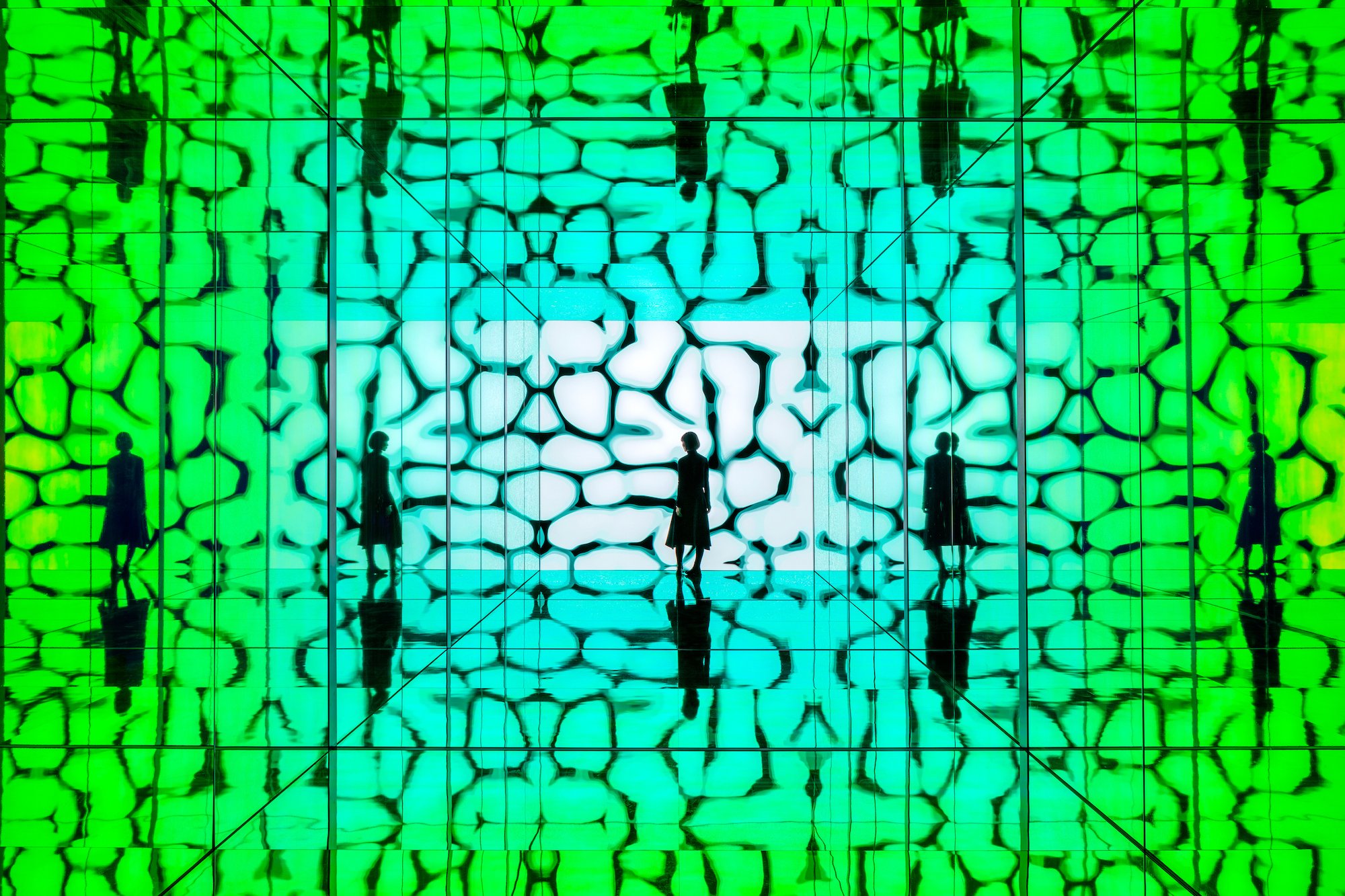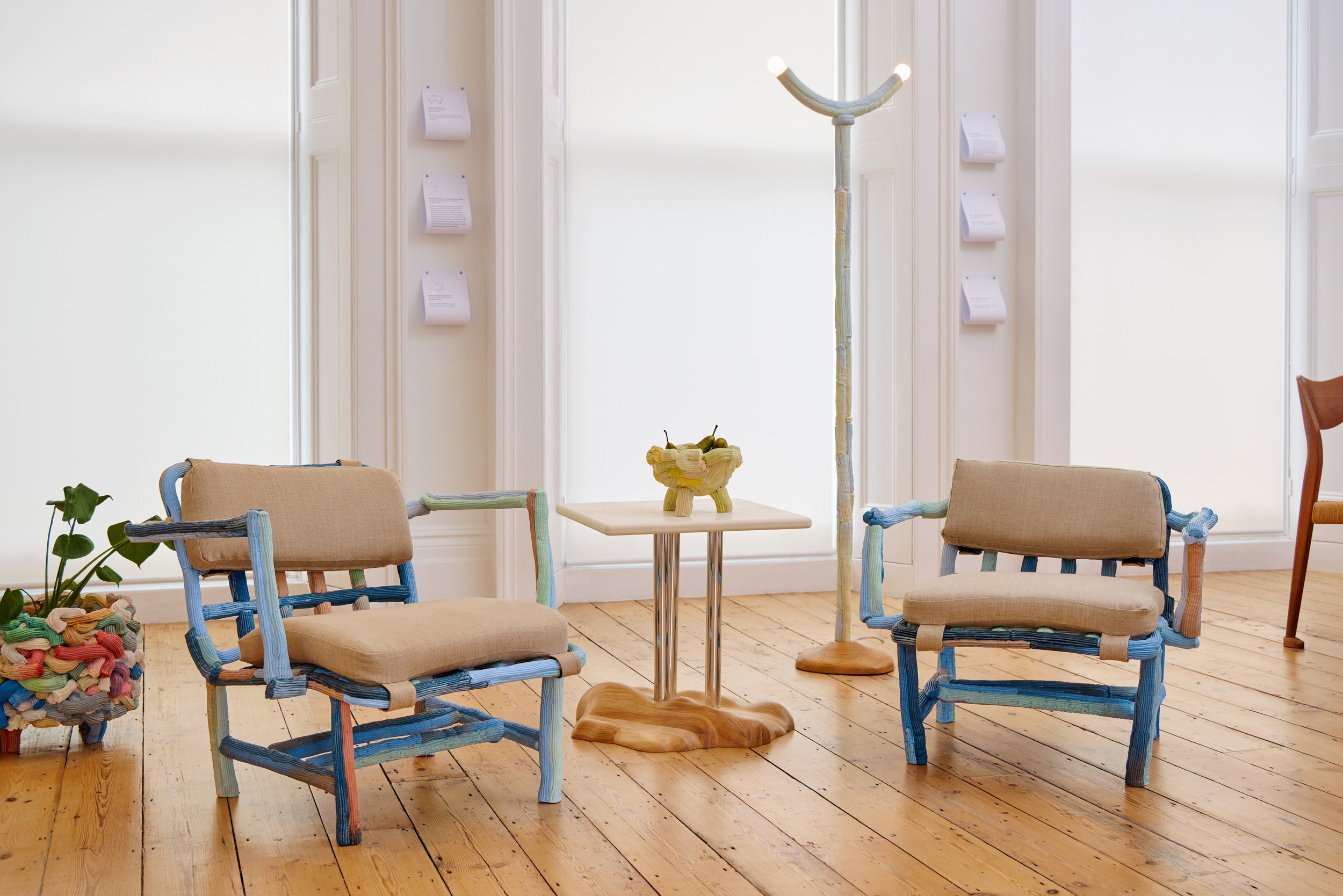LDF 2022 Diaries: Day One
Sony’s contribution to the 2022 London Design Festival (image: Ed Reeve).
This week the Disegno team is crisscrossing London for the 2022 edition of the city’s annual London Design Festival (LDF). Over the coming days we’ll be reflecting on some of the events and installations from across the festival and highlighting the projects that stood out to us. The first dispatch follows below.
Two Kettles, No Sofa (image: Paul Plews).
A domestic arrangement
Gallery shows can frequently be a staid affair: exquisite objects, displayed exquisitely, that may be nice in their own way, but which are often lacking in narrative or critical impact. What a pleasure, then, to see Seeds experiment within the form through Two Kettles, No Sofa, a display from designer James Shaw and writer Lou Stoppard. Shaw and Stoppard are a couple and their show is lightly autobiographical, exploring what happens when two people move in together – a familiar aspect of domesticity, but one that has been little explored within design. The show offers a fine excuse to delve into Shaw’s superb and unmistakable Plastic Baroque objects (as if much of an excuse were needed to enjoy their chaotically extruded forms), which are further enlivened through their juxtapositions with a selection of design classics, but it’s these pieces’ relationship with the captions and accompanying short story provided by Stoppard where the show really sings. Telling the story of fictional couple Justine and Edward, Stoppard’s snippets about domestic life are delicious and witty (“In the three years immediately after leaving university, Edward did not read a single book,” displayed next to an aluminium side table that should probably contain books; “Justine smokes between 10 and 20 cigarettes a week. When her GP asks her if she is a smoker, she says no,” alongside a candle holder) and enrich the objects though their narrative. It makes for an original and entertaining exhibition, and one that injects new energy into the format; objects, even when exquisite, can be rich in the complexities, banalities and profundities of everyday life.
Two Kettles, No Sofa: 4 Cromwell Place, SW7 2JE
Into Space by Sony (image: Ed Reeve).
A sensory space
Technology brand presentations at design weeks typically go heavy on spectacle, but light on content: they’re opportunities to razzle-dazzle visitors and not get too bogged down in any of the actual business of design. In some respects, Into Sight by Sony fits this template. The tech giant has created an immersive space whose cuboid dimensions begin to break down into shifting patterns of light, colour and sound, the formal boundaries of the installation extending into infinity through a clever use of mirroring – it’s like standing within a constantly shifting rainbow and is, unquestionably, spectactular. It is a mesmerising effect and one that you could happily spend an extended period enjoying, but Sony also deserves credit for not solely trading on this spectacle. Every element within the installation (from the reflective surfaces, to the digital displays and camera that tracks users’ movements within the space and adapts the experience accordingly) is a technology that features within Sony’s standard products, providing an insight into the actual elements with which the brand creates its designs. It is a small but worthwhile gesture, and one that provides a depth to the display that might otherwise be absent – a beautiful, memorable experience that has been achieved using market-ready technology.
Into Sight: Pavilion Gallery, 4 Cromwell Place, SW7 2JE
No Ordinary Home (image: Andy Stagg).
Variations upon a theme
A group show that draws upon designers of the calibre of Martino Gamper, Gemma Holt and Max Frommeld ought to be worth visiting, and thankfully No Ordinary Home – a part of Brompton Design District – lives up to expectations. The show has a simple premise: 14 designers have created vessels that can hold a plant and things don’t get more complex than that, but the pleasure lies in seeing the sheer variety of making techniques and materials that the different practitioners have employed in order to achieve their aims. Oscar Wanless offers a precise metal mobile, with pot plants suspended from its carefully positioned appendages; Attua Aparacio Torinos presents a masterclass in experimental ceramic vessels (including one form that looks as if it has been knitted); while Jon Harrison veers into more industrial territory, with plinths for plants positioned atop steel and aluminium profiles. It’s a beautiful show offering a simple, but nevertheless fascinating, exploration of the scope for experimentation and diversity within a given design typology. There’s more than one way to skin a cat, and there’s more than one way to house a plant.
Martino Gamper and Friends: No Ordinary Home: 4 Cromwell Place, SW7 2JE
Graham Secrets the puffin, repaired by Ng Si Ying (image: R for Repair).
Make do and mend
In theory (if not always in practice), everyone within design knows that repair represents a vital part of the discipline’s future. Kudos, then, to Hans Tan and Jane Withers for curating R for Repair, a show that offers an intelligent and emotionally affecting reflection on the practice and its implications. The show highlights a series of broken objects that were donated by the public, which have subsequently been repaired by designers in both Singapore and the UK, and the breadth of takes on the topic that they have provided is refreshing. The repair work ranges from celebrations of craft (Ng Si Ying’s gorgeous rattan repair for a broken toy puffin – that, full disclosure, belongs to Disegno’s editor); to the conceptually provocative (Studio Mama’s ingenious repair of doll’s house furniture by simply creating a new doll’s house for it to inhabit); the playful (Brown Office’s brilliant disassembly of a kitsch Winnie the Pooh clock); and the emotionally profound (step forward Thomas Thwaites, who created a resin cast of the favourite ball of Lucky, a now deceased dog whose owner couldn’t bear to part from his pet’s toy). Repair is a social necessity, but Tan and Withers have done superb work in highlighting the range and complexity of the practice, and the different ways in which it intersects with design culture. It is a small display, but a necessary one.
R for Repair: Design 1900-Now, V&A, SW7 2RL
Chila Kumari Singh Burman’s Remembering a brave new world, the Tate Britain Winter Commission 2020-21, which was displayed as part of We Are Here (image: Joe Humpreys, courtesy of Tate).
We were there
Take a bow Debika Ray, Manijeh Verghese and Spandana Gopal, the organisers of the We Are Here event hosted at Dalston’s Rio Cinema on 18 September. Billed as “a celebration of architecture, objects, community and migration”, the event mixed panel discussions with DJ sets, art and film to create a platform that offered a superb exploration of diaspora and its essential role in London’s (or, indeed, any city’s) urban and cultural realm. We Are Here drew upon thought-provoking speakers including Michael McMillan, Nabil Al-Kinani and Tola Ojuolape to explore design across different scales (cities, objects and interior spaces), but it was refreshing to see this kind of curated content mixed in with more spontaneous music and discussion – a worthwhile reminder that cultural production takes many forms, and that different registers of creative practice can sit comfortably alongside one another. We Are Here took on an essential, complex and under-discussed theme, and it deserves full credit for having done justice to it. Fingers crossed it becomes an annual event.
We Are Here: Rio Cinema, 107 Kingsland High St, E8 2PB






